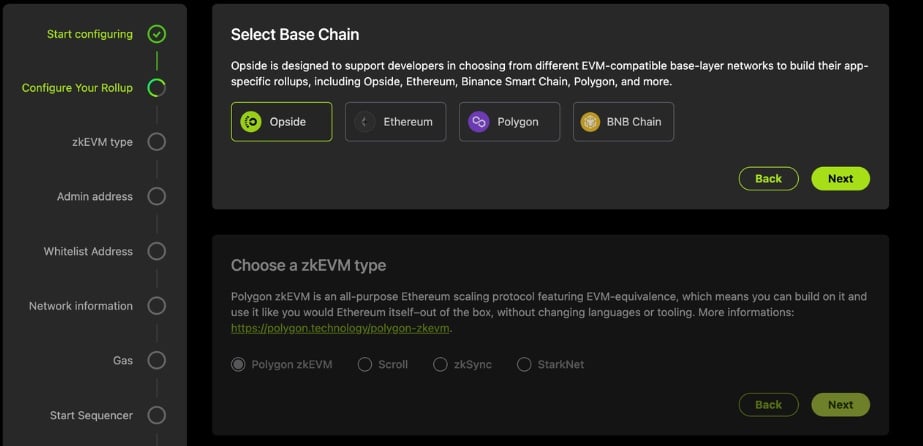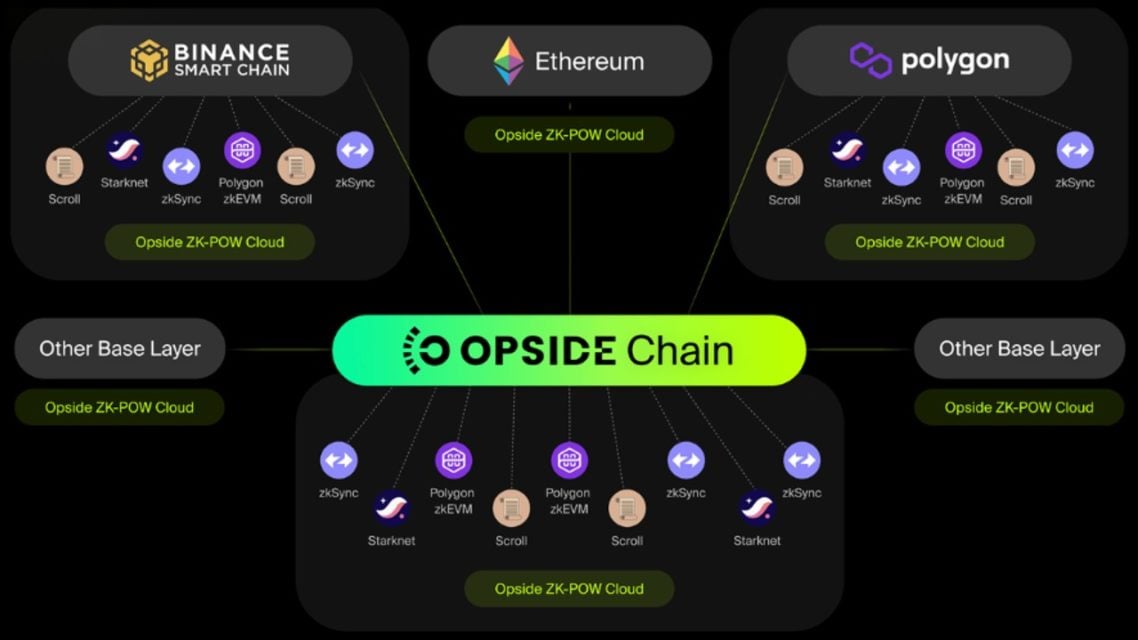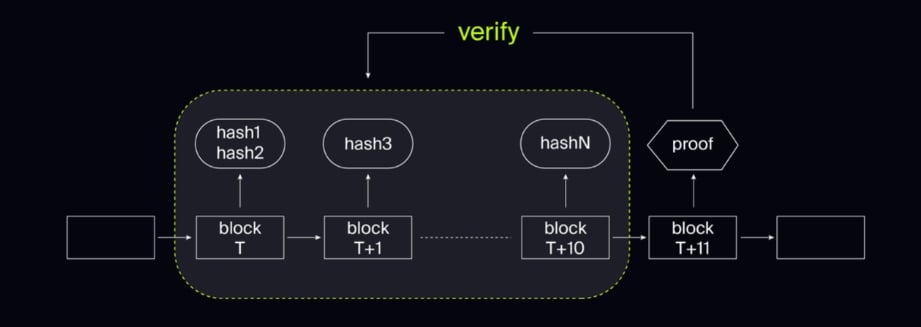Opside is a decentralized ZK-RaaS (ZK-Rollup as a Service) platform as well as a PoW (Proof of Work) network that facilitates ZKP (Zero-Knowledge Proof) mining.
Opside uses a hybrid consensus mechanism that combines PoS and PoW. This platform offers a unique feature for Web3 developers to create zkEVM application chains with one click. The abundance of ZK-Rollups creates a significant need for computational power and creates a beneficial mining environment for global miners.
The L2 concept is widely accepted in scalability solutions. However, L2 does not adequately manage various hardware resources such as data availability, ZKP computing power, or packaging nodes. Also, running an L2, especially a ZK-Rollup, requires significant hardware maintenance costs and a high level of technical proficiency, which can be a push for many developers. To meet these challenges, Opside introduced the ZK-RaaS concept.
This service allows developers to initiate zkEVM chains within a minute without the need for detailed knowledge of ZK or chain nodes. Opside also introduced the ZK-PoW concept, inviting miners to participate in the maintenance of zkEVM and calculation of ZKPs.
Opside’s goal is to simplify the use of ZK-Rollup and promote wider adoption, thereby facilitating large-scale deployment of zkEVM-based application chains. Developers can deploy their ZK-Rollups (zkEVM) to multiple chains with one click.
For miners, Opside serves as a multi-chain PoW protocol that supports ZK mining and generates zero-knowledge proofs for ZK-Rounds on various public chains.
ZK-RaaS
ZK-RaaS (ZK-Rollup as a Service) provides one-click ZK-Rollup creation service to all users. Opside provides a generic ZK-Rollup launch area that allows developers to effortlessly deploy different types of ZK-Rollups to different base chains. These underlying chains include Ethereum, Opside chain, BNB chain, Polygon PoS, and other public chains. ZK-Rollup (zkEVM) types include zkSync, Polygon zkEVM, Scroll, StarkNet, and other zkEVMs, as well as other ZK-Rollup variants.

Opside deploys a Rollup System Agreement (RSC) in each base chain to manage the lifecycle of Rollups in that chain, including enrollment, suspension, and withdrawal. Developers can own a ZK-Rollup by renting a Rollup slot with a certain number of IDEs (Opside native tokens).
The idea of a Rollup slot can be compared to a slot in Polkadot or an app chain in Cosmos. However, Cosmos’ application chain requires maintaining its own consensus layer and cross-chain bridge, which presents significant security risks. In contrast, ZK-Rollup implements ZK technology, which mathematically provides a shared layer of consensus and data availability between Rollup and the underlying chain. This method is safer, more decentralized and has lower maintenance costs.
By renting a Rollup slot, developers get a standalone execution environment where they can have a unique ZK-Rollup chain. Developers can fully control ZK-Rollup and customize its economic model, including the choice of gas tokens. They can freely set gas prices down to zero, thus exempting users from paying any fees.
No hardware costs are imposed on developers. All hardware resources such as data availability, sequencer and ZKP computing power are decentralized and provided by the Opside ZK-PoW cloud.
Also, local cross rollup communication can be implemented between different ZK-Rollups on the same base chain. This is a message communication mechanism that allows an address on one roll to interact directly with a contract on another roll. This feature significantly addresses fragmentation of user assets and improves interoperability between applications.
Opside ZK-PoW Cloud

Compared to OP-Rollup, ZK-Rollup has several advantages such as improved security, unreliable transactions and higher withdrawal speeds. A key technological difference is that ZK-Rollup requires strong ZKP computing power to generate zero-knowledge proofs.
Opside’s Multi-Chain ZK-PoW Mechanism
Opside ZK-PoW Cloud’s multi-chain ZK-PoW mechanism will be deployed on multiple chains, including but not limited to Ethereum, BNB Chain, Polygon PoS, and Opside Chain itself. With Opside’s design, developers can deploy ZK-Rollups to these different base chains. As ZK-Rollup technology matures, we may see hundreds or even thousands of ZK-Rollups, which could lead to significant demand for ZKP computing power.
After the transition from Ethereum PoW to PoS, many Ethereum mining machines lost their application scenarios. These machines are valued at around 12 billion USD in terms of capital scale and many of them are currently idle. With the large-scale implementation of ZK-Rollup, the creation of ZKP requires a large number of hardware and mining machines such as CPUs, GPUs and FPGAs to provide computational capacity.
Opside uses the ZK-PoW mechanism to incentivize miners to provide ZKP computing power, thus providing comprehensive hardware infrastructure for ZK-Rollup. This is one of Opside’s core ideas. All participants, including users, developers and miners, can benefit from this Opside economic model.
Two-stage submission mechanism for ZKP verification
To encourage more miners to participate in ZKP computation tasks at the same time, Opside proposed a two-stage submission mechanism for ZKP verification. The share of PoW rewards for a ZKP will be distributed to the active ZKP sender, i.e. the miner, according to certain rules.

- Submit proof hash: Multiple miners can participate in calculating the zero-knowledge proof within a given time frame for a given sequence. After each miner calculates the proof, he does not send the original proof directly, but calculates the proof hash (proof/address) and sends this proof hash to the contract.
- Submit ZKP: After the timeframe expires, the miner sends the original proof and validates it against the previously submitted proofhash. Miners who pass this verification receive PoW rewards and the reward amount is distributed according to the miner’s stake. Please refer to ZKP’s Two-Step Shipping Algorithm for more details.
Optimized ZKP Generation Algorithm
Once Rollup’s smart contract validates ZKP, it can lead to on-chain attacks if original proof is presented. To prevent such attacks, ZK-Rollup often takes additional actions to hide the original evidence data. Opside’s innovative two-step forwarding algorithm for ZKP takes advantage of a “submit first, verify later” approach, avoiding unnecessary bulk calculations for proof and address.
Moreover, in some open source zkEVMs, ZKP computation and submission takes place sequentially. When ZK-Rollup sends a large number of strings, it can become a bottleneck as miners cannot compute multiple ZKPs at the same time. Opside’s two-stage sending algorithm enables ZKP to be computed in parallel and sent sequentially, allowing miners to perform multiple ZKP generation tasks simultaneously, significantly increasing ZKP generation efficiency.
The Opside team also improved the ZKP recursive aggregation algorithm, significantly improving the machine resource utilization in the cluster and further speeding up ZKP computations. Stress tests in practical environments showed that miners using a 20-unit machine cluster (each with a 128-core CPU and 1TB of RAM) maintained a processing speed of 27.8 TPS for about 40 minutes. Under similar conditions, Opside was able to reduce the average transaction confirmation time from about 5-6 minutes to about 3 minutes, increasing ZKP production efficiency by about 80%.
With the participation of more ZK-Rollups and miners, the demand and supply scale of the ZKP computing power market will continue to expand, making the efficiency improvements offered by Opside’s PoW algorithm increasingly evident.
Opside Chain
Opside Chain not only supports Opside ZK-PoW Cloud as one of the core chains, but also offers further optimizations for ZK-Rollup. These include the use of pre-compiled contracts for accelerated ZKP verification, support for data fragmentation, and the adoption of a PoS consensus based on ETH 2.0. In the future, support will also be extended to EIP-4844, DankSharding and other full-shard solutions, reducing Rollup gas costs to almost zero.
Ethereum is currently the world’s largest decentralized network with over half a million nodes. These nodes offer significant decentralization and, looking into the future, are poised to provide enormous data availability thanks to data storage technology. Inspired by Ethereum, Opside Chain has chosen to develop the PoS consensus derived from ETH 2.0. We estimate that Opside Chain will have an impressive network of over 100,000 nodes.
When considering aggregation, the question arises of how to further decentralize the sequencer rather than relying on a single node for central packaging. A practical approach is to effectively separate the roles of originator and recommender, allowing Opside Chain’s block proposers to also propose blocks for the Aggregation Layer. While the generator is powered by a permissionless P2P network, the recommender is based on Opside Chain’s block recommender. This methodology eliminates the availability risk of a single node while maintaining Miner Extractable Value (MEV) and resistance to censorship.
As a result, Opside Chain offers a standardized decentralized sequencer mechanism in which block proposers also propose blocks for Aggregation. In this way, ZK-Rollup not only inherits security from the top layer, but also inherits a degree of decentralization.
Opside Chain offers a hybrid consensus model that includes PoS and PoW:
In the opside chain:
PoS: Opside plans to adopt and replace Ethereum 2.0’s PoS algorithm. It allows anyone holding Opside tokens to become validators and then receive block rewards and gas fees within the Opside chain.
In the aggregation layer:
PoS (Sequencer): Validators propose blocks in both the Opside Chain and the Aggregation Layer (i.e. chunks of data). Hence, they also act as sequencers in the Aggregation Tier, where they can earn gas fees from transactions.
PoW (Verifier): Any person with sufficient computing power for ZKP calculations can become a prover in the Aggregation Layer. Under PoW rules, the proofers generate zk proofs from the Aggregation Layer blocks sent by the sequencer.
In comparison, ZK-Rollup is like a computer; The hard disk is represented by the data availability offered by PoS, and the CPU is reflected by the computing power delivered by the PoW. Opside Chain’s mission is to strike a balance between PoS and PoW so that all parties can maximize their contribution and benefits, thereby improving the performance and user experience of a large-scale ZK-Rollups network.
Supply and Demand of IDE Tokens
Regarding the supply and demand of tokens, Opside tokens (IDE) will be minted as PoS and PoW rewards, appealing to Verifiers and Miners respectively. During the Pre-Alpha testnet phase, the block reward ratio of PoS to PoW is provisionally set at 1:2. In the future, this rate will be adjusted dynamically according to the supply-demand relationship of the network’s ZKP computing power.
PoS Awards
As mentioned earlier, Opside Chain uses an advanced PoS consensus based on ETH 2.0. To act as a validator, users must deposit a certain amount of IDE tokens into a deposit contract and run three separate software modules: an execution client, a consensus client, and a Validator. These Validators oversee the verification of new blocks circulating on the network and from time to time also generate and emit new blocks themselves. If a Verifier is found to be dishonest or inactive, their staked IDE will be forfeited as a penalty.
Under the PoS mechanism, Opside Chain maintains a stable block generation rate. The time slot is divided into slots lasting 12 seconds each and epochs of 32 slots. In each slot, a random validator is chosen to propose a new block. This validator is responsible for generating the new block and broadcasting it to the rest of the network. Similarly, a random committee of validators is chosen during each slot, and their collective votes confirm the validity of the proposed block. For a detailed understanding of this mechanism, please refer to Ethereum’s PoS consensus model.
For the Alpha testnet phase, the Opside Chain is set to include EIP-4844. This introduces Data Availability Sampling (DAS), a tool used to ensure that transaction data from ZK-Rollup is available after execution without overloading any node. In practice, each validator will randomly pull transaction data from the blob to verify its existence. The same method can also ensure that all data from block producers is accessible to secure light clients. In line with the Suggestor-Constructor Segregation (PBS) principle, only block producers should process the entire block, while other validators will use data availability sampling for validation.
Please note that Opside Chain may vary according to certain parameters; The latest values are available from the code repository.
Overall, staking encourages individual participation in network protection, thereby promoting decentralization. Authenticator nodes can be run on regular laptops. Some delegation staking pools even allow staking activities for users who do not have enough IDE tokens.
PoW Awards
Based on the ZK-Rollup launchpad provided by Opside, developers can choose to have their own ZK-Rollup on a base chain. To support the massive hardware resources required by multiple ZK-Rollups, Opside offers a unified ZKP computing market, encouraging miners (or proofers) to produce ZKP for these ZK-Rollups. This is Opside’s ZK-PoW mechanism.
Single Pick Up Order Reward Allocation
ZK-PoW is a multi-chain protocol, meaning that PoW rewards will be distributed across several underlying chains, including Ethereum, Opside Chain, BNB Chain, and Polygon PoS. The number of PoW rewards for each base chain depends on the number of Gathering slots registered, ZKP workload, etc. it depends.
For each base chain, within a block, each Aggregation can send only one string (this string can contain multiple blocks of the Aggregation). Each thread will equally share the current block’s PoW rewards. This means, for example, if there are four Aggregations sending sequences within a block in the base chain, the PoW rewards will be split into four parts, and each sequence will receive a quarter of the block’s PoW rewards. Of course, some blocks may not have any Rollups sending a sequence, so the actual inflation of the PoW may be lower than expected.
In the future, each series will be based on the respective ZK-Rollup type, the number of Rollup operations, gas usage, etc. to price different series differently. based on workload estimates.
Staking Prover and Penalties
In order to prevent malicious behavior related to proofers, proofers are required to sign up for a specific system contract and stake tokens. Validators are free to participate in PoW mining of one or more Rollups. Validators are required to deposit a certain amount of IDE in the system contract for each Aggregation they wish to participate in. If the current share is below the threshold, they are not allowed to send ZKP for that Collection. The rewards won by the proofers for the ZKP presentation will be distributed according to the odds ratio, thus preventing the malicious behavior of the proofers who have submitted ZKP more than once.
Verifiers will be penalized differently for the following actions:
- If a proofer sends a wrong hash.
- If no ZKP passes the verification, all proofs that submit a hash will be penalized. Confiscated Opside tokens will be burned.
For more details and considerations about the two-stage sending mechanism for ZKP, please refer to the official documentation. Specific figures for Prover shares and penalties may change in the future.
Developers Rent Rollup Slots
On each base chain, Opside will deploy the ZK-PoW protocol. Developers can register a Rollup slot with one click on the ZK-Rollup launchpad and thus create their own ZK-Rollup. All hardware resources for this ZK-Rollup are provided by the decentralized Opside network. Developers have to pay for the Rollup slot’s rent, and that portion of the rent is burned directly.
In addition to a fixed rental amount, developers can also provide additional ZKP subsidies for their ZK-Rollups to encourage miners to provide computing power.
Specific rules and parameters for rent and subsidies can be found in the official documentation or code repository.
Governance and Development
The functions and performance of the Opside network will continue to evolve over time. Here are a few examples of higher priorities:
- Dynamically adjust the reward distribution rate of PoS and PoW according to the supply and demand relationship of ZKP computing power in the whole network.
- The validator’s data sharding and data availability sampling will accommodate more ZK-Rollup ecosystems, providing more storage for the entire Rollup Tier.
- The separation of the Aggregation proposer and generator allows the Aggregation layer to use the Opside chain’s validator as the block recommender and inherit decentralization from the previous layer.
- Optimizing miners’ staking and slashing mechanisms encourages miners to provide continuous and stable ZKP computing power.
- Application developers subsidize the ZKP production of their Rollups to encourage miners to provide computational power.
- Depending on the ZK-Collection type, Number of Collections, gas usage, etc. to create a personalized pricing mechanism for Collection lots. based workload estimates. These improvements will significantly increase the usefulness of the Opside network, thereby promoting the long-term development and prosperity of ZK-Stacking as a Service.
After the launch of the Opside mainnet, an Opside DAO will be established with a reasonable process and mechanism to jointly determine the future of the network. All updates to the parameters and mechanisms of the Opside mainnet will be determined through the Opside DAO. It is important to emphasize that Opside is a co-built economy and has evolved over time.
Future improvements will be detailed in the DAO proposals, and how these plans benefit the long-term interests of the Opside economy and each category of contributors will be explained. As the network evolves, it is crucial to build an economy that can function independently and robustly without the need for multiple tools and subsidies.